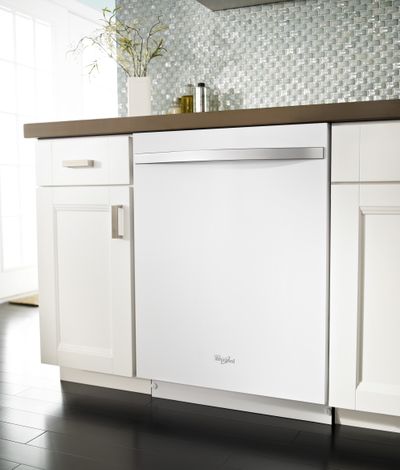Those cleaning appliances in your kitchen need love, too

If there are spots or stuck-on grime on the dishes when they come out of the washer, or if the sink has an unpleasant odor even after you clean it and run the disposal, it means these hardworking appliances may need extra attention.
“Dishwashers and drains battle kitchen waste and activity daily, which can take a toll on the appearance and performance if not cleaned correctly,” said Chris Salatino with Kenmore Major Appliances.
DISHWASHERS
Electric dishwashers have a filtration system that requires regular cleaning, especially if you don’t scrape or pre-rinse dishes.
“The maintenance on a dishwasher depends on how you treat it,” said John DeSilvia, host of DIY Network’s “Rescue My Renovation.”
If you’re not a pre-rinser, he recommends cleaning the filter once a month. Just look at the bottom of your dishwasher, find and remove your filter, then scrub away debris with a soft brush. Rinse and reinstall.
“Don’t be scared, it’s really easy,” DeSilvia said.
If in doubt, check your owner’s manual on how to find and remove the filter. Can’t find the instructions? Log on to your manufacturer’s website. Or online tutorials at sites such as DIYNetwork.com and YouTube.com can help you through the process.
The interior of your dishwasher may also appear filmy at times. To get rid of that buildup, Salatino advises waiting until the washer has finished a cycle and cooled. Then make a paste with powdered detergent or use liquid detergent on a damp sponge to wipe away mineral deposits. Follow up by running a normal cycle.
If you’re in a hard water area and wiping with detergent doesn’t remove all the film, run a normal cycle with 2 cups of white vinegar in an upright glass on the lower rack. Salatino advises turning off the “heated dry” option during the cycle.
There also are commercial cleaners marketed especially for mineral buildup in dishwashers.
Consumer Reports recommends replacing worn or rusted dish racks, and using care when loading dishes and silverware so you don’t damage spray arms. Inspect the arms to make sure they aren’t clogged with debris, which could affect water pressure. Use pipe cleaners to dislodge blockages.
For cleaning the outside of your dishwasher, Salatino says all you need is a soft, damp cloth or sponge and mild detergent. If you’ve got a stainless steel cover, you’ll need a special cleanser.
SUPER SUDS
Phosphates, which help control water hardness, were eliminated from dishwater detergents a few years ago over pollution concerns. Since then, some consumers have complained that dishes don’t seem as clean.
Lucinda Ottusch, with Whirlpool’s Institute of Kitchen Science, says one mistake people make is buying cheap detergent. She says the all-in-one packets by name-brand companies really do help your dishwasher perform best.
She also recommends a rinse aid, which promotes drying by allowing the water to sheet off dishes.
Loading your dishwasher properly also can aid cleaning. Find tips at http://www.instituteofkitchen science.com/kitchen-101/ dishwashers.
And, you don’t have to wait until the dishwasher is full to run a cycle. Ottusch says many newer models sense the size of a load and how dirty the dishes are, and work accordingly.
“Running the dishwasher takes very little water and energy, and waiting until it is packed full of dishes can compromise cleaning performance,” she said.
DIRTY DRAINING
If you’ve got a smelly drain, there’s probably bacteria growing in it.
To eliminate the problem, start by mixing a cup of baking soda and a cup of vinegar. Pour the mixture down the drain, let it sit for 15 minutes or more, then run the disposal and rinse with hot water.
To clean disposal blades, freeze white vinegar in ice cube trays and let the disposal grind away at them. The ice will help dislodge stuck-on debris, and the vinegar freshens the unit.
If there’s still an odor, try pouring in half a cup of bleach, but not if you have a septic system. You may need to go buy a live enzyme product that eats away bacteria, or a corrosive cleaner meant to unclog drains.
If your sink’s drain plug has moldy buildup, soak it in a vinegar or bleach solution, then wipe away any remaining grime. If mold builds up again quickly, replace the plug. Home improvement stores should offer styles that fit your sink, and some even stock scented versions.
If unpleasant odors continue, consider whether you might have a backed-up disposal or clogged plumbing.
THE GRIND
The crunching and gnashing of your disposal may make you leery of touching it, but there are ways you can keep it running well without calling a professional.
DeSilvia said to always run cold water before, during and after using the disposal.
“Never use hot water with your garbage disposal,” he said. “It breaks down food, causing it to liquify and accumulate around your pipes.”
It’s best to scrape large pieces of food into the trash can, then let the disposal take care of smaller scraps. Don’t put potato peels, shellfish, coffee grounds or other fibrous foods into the disposal. They’re clog-makers.
DeSilvia reminds homeowners never to put their hand in the disposal. If it won’t grind, use the reset button, usually a black or red button on the bottom of the unit. Make sure the outlet the disposal is plugged into is working.
If the disposal seems jammed, use the Allen wrench or similar hand-crank tool that comes with the unit to give it a push start. If you can’t find yours, many hardware stores carry them.
“Most service calls can be avoided by simply resetting your disposal,” DeSilvia said. “Press the button and you are good to go. Just saved yourself 300 bucks for a service call.”